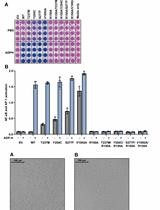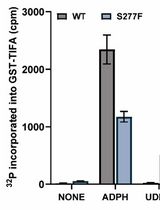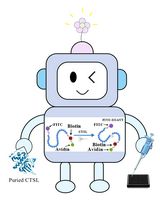- EN - English
- CN - 中文
Production, Purification, and Fluorometric Activity Assay of Human Aldehyde Dehydrogenases
人醛脱氢酶的生产、纯化和荧光活性测定
发布: 2022年09月05日第12卷第17期 DOI: 10.21769/BioProtoc.4505 浏览次数: 2214
评审: ASWAD KHADILKARMario ValentinoKomuraiah Myakala
Abstract
Human aldehyde dehydrogenase (ALDH) isoforms are NAD(P)+-dependent enzymes catalyzing the oxidation of a wide spectrum of aldehydes to their corresponding carboxylic acids. ALDH families 1 and 3 are associated with stemness, chemoresistance, and tumor progression across multiple tumor types. ALDH2 is involved in ethanol metabolism, and its deficiency is associated with a wide range of diseases. This protocol includes a method for recombinant protein production and affinity purification under reducing conditions that apply to ALDH family 1 and 3 isoforms, to produce high yields of pure, catalytically active protein (10–30 mg/L of culture). It also includes their respective enzymatic activity assays, optimized and based on the fluorescence emission of NAD(P)H at 460 nm, using hexanal (for ALDH1A1, 1A2, 1A3, and 2) or p-nitrobenzaldehyde (for ALDH3A1) as a substrate. These assays offer higher sensitivity than common UV-visible spectrophotometry and avoid interference of compounds that mask NAD(P)H absorption at 340 nm. The protocol could be adapted to high-throughput screenings using a fluorescent microplate reader. Not a single protocol existed in the literature that comprehensively addressed the methodology entailed in the production, purification, and fluorometric activity assays of the five isoforms. This standardized protocol, allowing a side-by-side comparison between the various isoforms and studies, is filling the gap and supersedes previously partial and scattered methodological information, representing an important contribution to the field. Here, high amounts of pure, soluble, stable, and catalytically active protein are obtained, which are suitable for crystallization trials and for the identification and characterization of substrates and inhibitors with therapeutic potential in the diagnostic and treatment of cancer and other diseases.
Keywords: Aldehyde dehydrogenase (醛脱氢酶)Background
The aldehyde dehydrogenase (ALDH) superfamily consists of a cluster of evolutionarily related NAD(P)+-dependent enzymes catalyzing the oxidation of a wide spectrum of aldehydic substrates, generated from various endogenous and exogenous precursors to their corresponding carboxylic acids. Accordingly, ALDHs participate in several cellular processes, including the detoxification of endobiotic and xenobiotic compounds. The ALDHs comprise 19 isoforms that are active in most mammalian tissues, with the highest level in the liver, followed by the kidney, uterus, and brain (Koppaka et al., 2012). The different isoforms present different subcellular localization (cytoplasm, mitochondria, endoplasmic reticulum, and nucleus) and assemble into dimers or tetramers to form the active protein (Marchitti et al., 2008).
Among the ALDH isoforms, ALDH members from families 1 and 3 have received increased attention as potential therapeutic targets in the treatment of cancer and other pathological conditions. The enzymatic activities of members from ALDH family 1 (e.g., ALDH1A1, ALDH1A2, and ALDH1A3) and family 3 (e.g., ALDH3A1) are commonly used as cancer stem cell markers, and are reported as involved in proliferation, drug resistance, and metastasis, which together contribute to cancer aggressiveness and poor prognosis (Feng et al., 2009; Greco et al., 2014; Li et al., 2014; Rebollido-Rios et al., 2020). Additionally, ALDH family 1 participates in the regulation of hundreds of genes during early developmental stages, via the production of retinoic acid (Iturbide et al., 2021). ALDH2, which is actually an ALDH family 1 member when considering sequence identity (Vasiliou et al., 2013), is the major enzyme involved in the oxidation of acetaldehyde during ethanol metabolism (Klyosov et al., 1996). The functional inactivation of ALDH2 is robustly associated with the development of certain types of cancers, including oropharyngolaryngeal, esophageal, stomach, colon, lung, head, and neck cancers (Muto, 2000; Yokoyama et al., 2001). Altogether, ALDH families 1 and 3 are considered promising targets for the diagnosis and treatment of cancer and other diseases (Duan et al., 2016). In addition, ALDH enzymes metabolize toxic aldehydes from lipid peroxidation to counterbalance the effects of reactive oxygen species (Singh et al., 2014).
With the aim to find novel, potent, and selective inhibitors against ALDH1A1, ALDH1A2, ALDH1A3, ALDH2, and ALDH3A1, the overexpression, purification, and determination of the specific enzyme activity of these five isoforms become essential procedures for structure-function studies and the identification and characterization of putative inhibitory molecules (Jiménez et al., 2019; Pequerul et al., 2020; Ibrahim et al., 2021, 2022; Castellví et al., 2022). Thus, it is of prime importance to tackle and optimize reproducible methodologies to obtain recombinant ALDH isoforms, as well as to develop side-by-side protocols for determining the standard enzymatic activity of members of human ALDH families 1 and 3. Only if the standard conditions are perfectly established, could we obtain high protein amounts for crystallization trials and structure-based drug design, as well as for developing screening procedures for novel inhibitors against ALDH isoforms.
Since ALDH1A1, ALDH1A2, ALDH1A3, and ALDH2 exhibit a role in the physiological oxidation of alkanals such as hexanal, this aldehyde was used as a substrate to measure the standard activity of these isoforms. Hexanal is a product of lipid peroxidation, and its concentration is increased in cancer (Janfaza et al., 2019). ALDH3A1 participates actively in the metabolism of exogenous aromatic aldehydes, such as cinnamaldehyde, anisaldehyde, vanillin, and benzaldehyde, which are usually found in food components (Laskar and Younus, 2019). Accordingly, p-nitrobenzaldehyde, which is chemically more reactive than benzaldehyde, was used as a standard substrate for this isoform.
Materials and Reagents
1.5 mL sterile tube (Sudelab, catalog number: 1002208)
250 mL Beckman tubes (Beckman Coulter, catalog number: 356011)
0.45-µm filters (ACEFESA, Whatman, catalog number: GE10462100)
1-mL quartz cuvettes (Teknokroma, Starna, catalog number: ST-29-F/Q/10)
96-well microplates (Sarstedt, catalog number: 82.1581.100)
E. coli BL21 (DE3) pLysS competent cells (Sigma-Aldrich, Novagen, catalog number: 69451-M)
pET-30 Xa/LIC expression vector kit (Sigma-Aldrich, Novagen, catalog number: 70073)
ALDH/pET-30 Xa/LIC constructs (Proteogenix, custom order catalog number: GS-GS002—Gene Synthesis Service—and GS-SBG03—Subcloning into expression vector for gene <3,000 bp; https://www.proteogenix.science/custom-gene-synthesis/)
Kanamycin (Kn) (Sigma-Aldrich, catalog number: 60615)
Chloramphenicol (Cm) (Sigma-Aldrich, catalog number: C0378)
Glycerol (Sigma-Aldrich, catalog number: G5516)
Kolle handle loop (Auxilab, P. SELECTA, catalog number: BRG501)
Tryptone (Sigma-Aldrich, catalog number: 95039)
Yeast extract (Thermo Fisher Scientific, catalog number: 212750)
Sodium chloride (NaCl) (Sigma-Aldrich, catalog number: S9625)
Isopropyl β-d-1-thiogalactopyranoside (IPTG) (Sigma-Aldrich, catalog number: I6758)
Trizma base (Sigma-Aldrich, catalog number: T6066)
Imidazole (Sigma-Aldrich, catalog number: I202)
Lysozyme (Roche, catalog number: 10837059001)
DNase (Roche, catalog number: 10104159001)
Triton-X 100 (Sigma-Aldrich, catalog number: X-100)
Phenylmethanesulfonyl fluoride solution (PMSF) (Sigma-Aldrich, catalog number: 93482)
DL-Dithiothreitol (DTT) (ACEFESA, Panreac AppliChem, catalog number: A1101)
PD 10 desalting column (GE Healthcare, catalog number: 17-0851-01)
Coomassie Brilliant Blue R 250 (Sigma-Aldrich, catalog number: 1.12553)
Bovine serum albumin (BSA) (Roche, catalog number: 10711454001)
Bradford reagent (ACEFESA, Panreac AppliChem, catalog number: A6932,0500)
Sodium dodecyl sulfate (SDS) (Sigma-Aldrich, catalog number: L3771)
BenchMarkTM protein ladder (Thermo Fisher Scientific, catalog number: 10747012)
Sucrose (Sigma-Aldrich, catalog number: S0389)
Bromophenol blue sodium salt (Sigma-Aldrich, catalog number: B5525)
Glycine (Sigma-Aldrich, catalog number: W328707)
Methanol (MetOH) (ACEFESA, LABKEM, catalog number: MTOL-0GH-2K5)
Acetic acid (VWR, catalog number: 20103.295)
HEPES (Sigma-Aldrich, catalog number: H3375)
Ethylenediaminetetraacetic acid (EDTA) (Sigma-Aldrich, catalog number: E5134)
Nicotinamide adenine dinucleotide (NAD+) (Apollo Scientific, catalog number: BIB3011)
Nicotinamide adenine dinucleotide (reduced form) (NADH) (Apollo Scientific, catalog number: BIB3012)
Hexanal (Sigma-Aldrich, catalog number: H9008)
Magnesium chloride (Sigma-Aldrich, catalog number: M-2670)
Nicotinamide adenine dinucleotide phosphate (NADP+) (Apollo Scientific, catalog number: BIB3013)
Nicotinamide adenine dinucleotide phosphate (reduced form) (NADPH) (Apollo Scientific, catalog number: BIB3014)
p-Nitrobenzaldehyde (Sigma-Aldrich, catalog number: 72800)
LB culture medium (see Recipes)
2× YT culture medium (see Recipes)
Bind buffer (see Recipes)
Elution buffer (see Recipes)
Equilibration buffer (see Recipes)
5× TMR charge buffer (see Recipes)
Running buffer (see Recipes)
Coomassie Blue colorant (see Recipes)
De-stain solution (see Recipes)
Reaction buffer A (see Recipes)
Reaction buffer B (see Recipes)
Reaction buffer C (see Recipes)
20 mM NAD+ stock solution (see Recipes)
500 µM NADH stock solution (see Recipes)
40 mM NADP+ stock solution (see Recipes)
500 µM NADPH stock solution (see Recipes)
2 mM hexanal (see Recipes)
2 mM p-nitrobenzaldehyde (see Recipes)
Equipment
Bibby ScientificTM StuartTM block heater (Fisher Scientific, catalog number: 10489438)
Incubator shaker (VWR, New Brunswick, model: Innova® 43)
UV-Vis spectrophotometer (Agilent Technologies, model: Cary 60)
Centrifuge (Beckman Coulter, model: Avanti® J-26 XP)
Fixed-angle rotor (Beckman Coulter, model: JA-14)
Fixed-angle rotor (Beckman Coulter, model: JA-25.50)
Sonic dismembrator (Fisher Scientific, model: FisherbrandTM Model 705)
ÄKTATM start FPLC (Fast Protein Liquid Chromatography) purification system (Cytiva, catalog number: 29022094)
Multiplate reader (Tecan, model: Tecan® Spark)
Bransonic cleaner (Fisher Scientific, model: B200)
PowerPacTM basic power supply (Bio-Rad, catalog number: 1645050)
Cary Eclipse fluorescence spectrometer (Agilent Technologies)
Software
Unicorn 7 (GE Healthcare/Cytiva, https://www.cytivalifesciences.com/en/us/shop/chromatography/software/unicorn-7-p-05649)
Spark ControlTM (Tecan, https://lifesciences.tecan.es/multimode-plate-reader?p=tab--3)
Cary WINUV (Agilent Technologies, https://www.agilent.com/en/product/molecular-spectroscopy/uv-vis-uv-vis-nir-spectroscopy/uv-vis-uv-vis-nir-software/cary-winuv-software)
Procedure
文章信息
版权信息
© 2022 The Authors; exclusive licensee Bio-protocol LLC.
如何引用
Pequerul, R., Porté, S., Parés, X., Pérez-Alea, M. and Farrés, J. (2022). Production, Purification, and Fluorometric Activity Assay of Human Aldehyde Dehydrogenases. Bio-protocol 12(17): e4505. DOI: 10.21769/BioProtoc.4505.
分类
生物化学 > 蛋白质 > 活性
您对这篇实验方法有问题吗?
在此处发布您的问题,我们将邀请本文作者来回答。同时,我们会将您的问题发布到Bio-protocol Exchange,以便寻求社区成员的帮助。
提问指南
+ 问题描述
写下详细的问题描述,包括所有有助于他人回答您问题的信息(例如实验过程、条件和相关图像等)。
Share
Bluesky
X
Copy link












